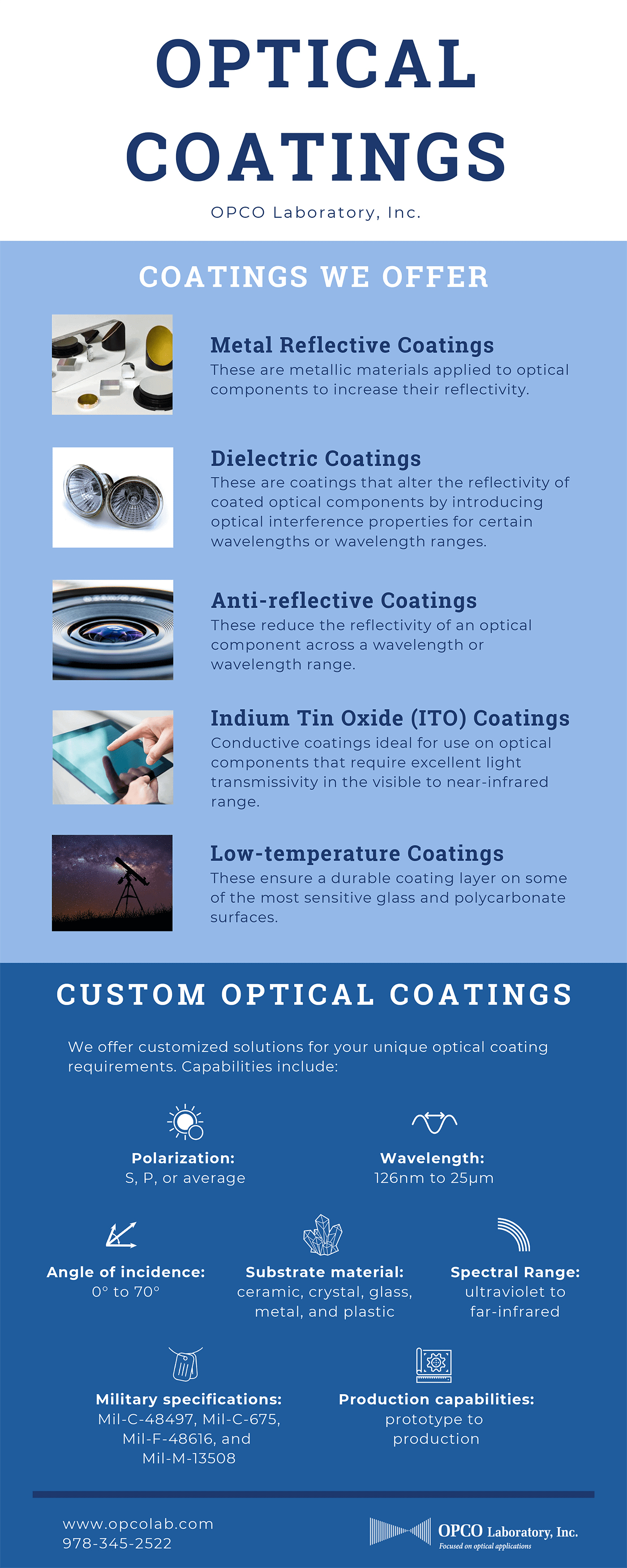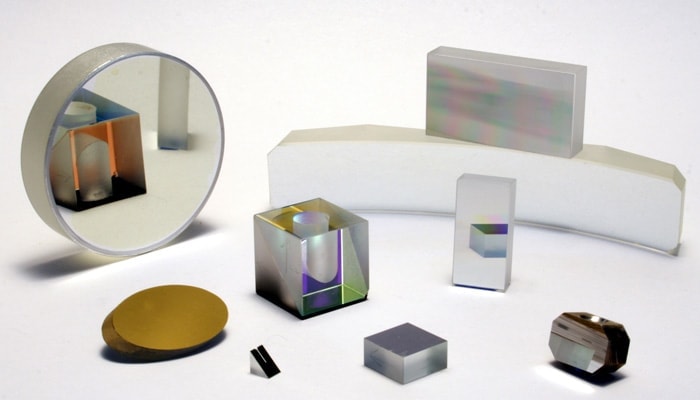Thin Film Optical Coatings
Thin film coatings refer to materials applied to components to enhance or add to the characteristics demonstrated by the base substrate. The process of depositing the coating onto the component surface is known as thin film deposition. While the thicknesses of the coating layers may vary depending on the coating material and technique employed, they generally range from one to tens of nanometers. In optics thin film coatings modify the element’s reflection and/or transmission to change the performance of an optical component. As such they significantly influence how the part performs within an optical system. For example, metallic coatings are applied to optical components such as mirrors and reflectors. Dielectric coatings allow for specific ratios of reflection to transmission across a particular wavelength range. At OPCO Laboratory, we specialize in providing full-service optical solutions to customers across a wide range of industries. In addition to fabricating and replicating optical assemblies, we offer optical coating services. OPCO has over 40 years of experience coating optical components using state of the art ion-assisted deposition (IAD) equipment, e-beam and resistive evaporation technologies. We have what it takes to provide our customers with high-quality optical components at a competitive price. Our coating capabilities include:
- Metal reflective coatings
- Dielectric coatings
- Anti-reflective (AR) coatings
- Indium tin oxide (ITO) coatings
- Low-temperature coatings
- Custom coatings
Below we provide an overview of the optical coatings we offer.
Metal Reflective Coatings
As suggested by the name, metal reflective coatings are metallic materials applied to optical components to increase their reflectivity across a particular range of the wavelength spectrum. One of the most common metals utilized in the manufacture of these coatings is aluminum which, depending on the formulation is used for visible and ultraviolet (UV) light applications. Other metals employed include gold for infrared (IR) and near-infrared (NIR) wavelengths and silver for Visible, NIR, and IR wavelengths. At OPCO, we apply metal reflective coatings to a variety of optical components in short to high volume production runs. Whether a customer supplies the part or requires a full-service (fabrication to coating) solution, we can meet their needs. Some of the typical metal reflective coatings we produce are:
- Aluminum, enhanced aluminum, and protected aluminum
- Bare chromium
- Bare copper
- Bare gold and protected gold
- Nickel alloys (NiCr, Inconel™)
- Bare platinum
- Enhanced silver and protected silver
We also offer custom metal reflective coating solutions to customers with highly specific or unique coating requirements. Our team can accommodate S, P or average polarization and 0° to 70° angle of incidence requirements and Mil-C-675, Mil-F-48616, Mil-M-13508, Mil-C-48497 standards. Examples of applications for these coatings include:
- Broad wavelength beamsplitters and ND filters
- Durable handheld and vehicle-mounted mirrors
- Vacuum ultraviolet (VUV) to IR spectrometer Mirrors
For additional information about these coatings, visit our metallic reflective coatings page.
Dielectric Coatings
Dielectric coatings alter the reflectivity of coated optical components by introducing optical interference properties for certain wavelengths or wavelength ranges. As a result, the optical element demonstrates reflectivity ranging from ~0 to ~100%, depending on the coating material, coating thickness, and number of coating layers. Some of the materials commonly used in dielectric coatings include magnesium fluoride and a variety of metal oxides. They can be applied in thin alternating layers by themselves or in combination with metallic coatings. At OPCO, we offer optical coatings for longpass (allows long wavelengths to pass through), shortpass (allows short wavelengths to pass through) and broadband applications. They can accommodate wavelengths from 190nm to 5µm. Examples of applications for these coatings include:
- Mirrors (e.g., hot or cold mirrors and optimized laser beam steering mirrors)
- Reflectors (e.g., partial reflectors for beamsplitters)
- Windows (e.g., windows for controlling and directing light throughput and polarization)
For additional information about these coatings, visit our dielectric coatings page.
Anti-Reflective (AR) Coatings
Anti-reflective (AR) coatings are used to reduce the reflectivity of an optical component at specific wavelength or across a wavelength range. As a result, the part achieves better transmission with higher contrast and lower risk of ghost images. At OPCO, we offer AR coatings for optical components made from a variety of substrates. Our team can create coatings that accommodate single, dual, or broadband wavelengths in the UV, Visible or IR ranges. Examples of applications for these coatings include:
- Beamsplitters
- Fiber optics
- Laser components
- Lenses
- Prisms
- Windows
For additional information about these coatings, visit our anti-reflective coatings page.
Indium Tin Oxide (ITO) Coatings
Indium tin oxide (ITO) coatings demonstrate high transparency and electrical conductivity. They are ideal for use on optical components that require excellent light transmissivity in the visible to near-infrared range. ITO-hybrid coatings combine the properties of standard ITO and other optical coatings. At OPCO, we offer ITO and ITO-hybrid coatings that accommodate sheet resistivity requirements ranging from 10 to 1,000 ohms per square for most glass and polymer substrates. They are suitable for light ranging from 0.4 to 2.5µm in wavelength. As ITO coatings allow for excellent electrical conductivity without inhibiting light transmission, they are commonly used for electronic components such as touchscreens, organic LEDs, and digital displays. Other examples of applications for these coatings include:
- Anti-fog windows vehicles and displays
- Electrically conductive electromagnetic interference (EMI) shielding
- Electrostatic control devices
- Heated windows for microscopy
- OLEDs, solar cells, and other semiconductor components
- On/off light blocking smart windows
For additional information about these coatings, visit our indium tin oxide coatings page.
Low-Temperature Coatings
Low-temperatures coatings are suitable for use on components that are sensitive to heat. A specialized thin film deposition process ensures industry professionals can achieve a durable coating layer on some of the most sensitive glass and polycarbonate surfaces. At OPCO, we offer low-temperature coating services for optical components made from ceramic, crystal, glass, metal, and plastic. The coatings accommodate customer requirements for wavelengths ranging from 190nm to 14µm and angles of incidence ranging from 0° to 70°.
Custom Coatings
In addition to the metallic, dielectric, anti-reflective, indium tin oxide, and low-temperature coatings indicated above, our team creates custom-tailored coating solutions for customers with unique optical coating requirements. Our capabilities include the following:
- Polarization: S, P, or average
- Angle of incidence: 0° to 70°
- Substrate material: ceramic, crystal, glass, metal, and plastic
- Military specifications: Mil-C-48497, Mil-C-675, Mil-F-48616, and Mil-M-13508
- Spectral Range: ultraviolet to far-infrared
- Production capabilities: prototype and production
For additional information about these coatings, visit our custom coatings page.
Partner With OPCO for Your Thin Film Optical Coating Needs
At OPCO Laboratory, we are an ITAR-registered company with over four decades of experience designing and manufacturing optical components and assemblies. These qualities combined with our ion-assisted deposition equipment allow us to produce high-quality standard and custom thin film coatings for a wide range of optical elements. To find out more about our optical coating capabilities or partner with us on your next project, contact us today.

